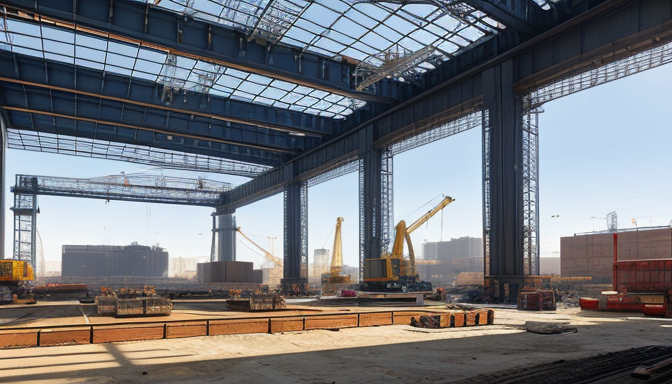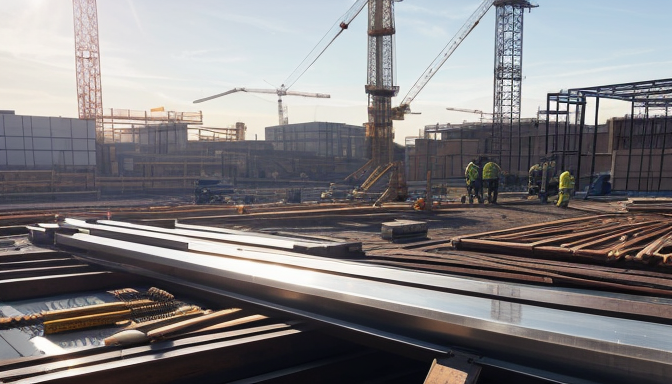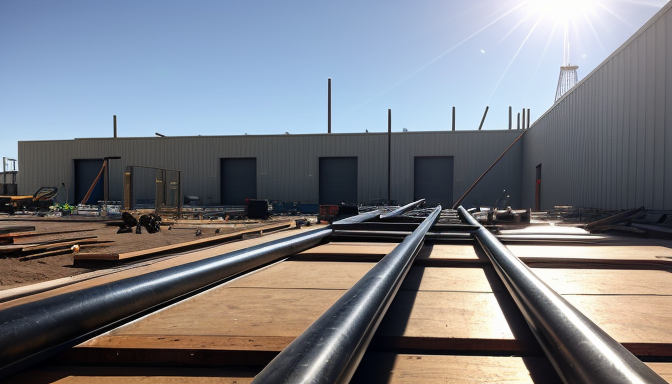When it comes to construction and engineering, steel beams are like the backbone of a structure. They provide strength and support, making them essential in building bridges, skyscrapers, and even homes. But what exactly are steel beams? Simply put, they are long, sturdy pieces of steel shaped to bear loads. Think of them as the strong arms holding up a heavy weight. Without them, structures would crumble under pressure.
Understanding steel beams is crucial for anyone involved in construction. Whether you’re a seasoned engineer or a DIY enthusiast, knowing the ins and outs of steel beams can help you make informed decisions. From their price and weight to their properties and sizes, there’s a lot to unpack. So, let’s dive deeper into the world of steel beams and see what makes them so special.
Steel beams come in various forms, each designed for specific applications. They are typically categorized into different types, such as I-beams, H-beams, and T-beams. Each type has its own unique shape and strength characteristics. The “I” in I-beams stands for the shape that resembles the letter “I”. This design allows for maximum strength with less weight, making it a popular choice in construction.
But why should you care about steel beams? Well, if you’re planning a construction project, understanding the factors that influence their price, weight, and properties will help you budget effectively and ensure safety. For instance, did you know that the price of steel can fluctuate based on market demand? This means that the cost of your steel beams might change from one week to the next. Keeping an eye on these trends can save you money and headaches down the line.
Moreover, the weight of steel beams is not just a number; it’s a critical factor in construction logistics. Heavier beams may require special equipment for transportation and installation. Imagine trying to lift a massive steel beam with a regular truck—it just won’t work! Therefore, knowing the weight of the beams you need can help you plan your project more efficiently.
In summary, steel beams are a vital component of modern construction. They offer strength, durability, and versatility. By understanding their various aspects—price, weight, properties, and sizes—you can make better decisions for your projects. So, whether you’re building a new home or a commercial building, remember that steel beams are your trusted allies in creating safe and sturdy structures.
I Steel Beam Price
The cost of steel beams can vary widely. Why is that? Well, several factors come into play. First, the size of the beam matters. Larger beams require more material, which means higher costs. Then there’s the grade of steel. Different grades offer different strengths and properties, and they come with varying price tags. Lastly, market conditions play a huge role. When demand is high, prices can spike. It’s similar to how the price of groceries can change based on the season.
To give you a clearer picture, let’s break down some average prices. Here’s a quick look at typical costs based on size and grade:
| Beam Size (inches) | Grade | Price per Foot ($) |
|---|---|---|
| 4 x 4 | A36 | 10.00 |
| 6 x 6 | A36 | 15.00 |
| 8 x 8 | A992 | 20.00 |
| 10 x 10 | A992 | 25.00 |
When budgeting for your project, it’s crucial to consider these factors. You might think, “How do I know what to budget for?” A good starting point is to consult with suppliers. They can provide you with current pricing and help you understand how your specific needs will affect costs.
Also, keep in mind that buying in bulk can sometimes lead to discounts. If you’re working on a large project, it might be worth your while to purchase a larger quantity. Just like buying in bulk at a supermarket, you often save more in the long run.
In conclusion, understanding the price of steel beams isn’t just about knowing the numbers. It’s about grasping the bigger picture. From size to grade to market trends, every detail counts. So, as you plan your project, keep these factors in mind. It’ll help you make smarter decisions and avoid unexpected costs down the line.

I Steel Beam Weight
The weight of steel beams plays a crucial role in construction and engineering. It’s not just a number; it’s a factor that influences the entire project. Why? Because understanding the weight helps in planning for structural integrity and logistics. Think about it: if a beam is too heavy, it could complicate transportation and installation. Nobody wants that kind of headache!
Calculating the weight of a steel beam is relatively straightforward. The formula typically used is:
Weight Volume x Density
Here, the volume is determined by the beam’s dimensions, while the density of steel is approximately 490 lbs/ft³ (or 7,850 kg/m³). So, if you know the size of your beam, you can easily figure out its weight. For example, a standard I-beam measuring 10 feet long, 10 inches wide, and 5 inches deep will weigh significantly more than a smaller beam of the same type.
But wait, there’s more! The weight also impacts other factors:
- Transport Costs: Heavier beams may require specialized vehicles.
- Foundation Requirements: A heavier structure needs a stronger foundation.
- Labor Considerations: More weight means more manpower for lifting and installation.
In construction, every pound counts. Imagine trying to hoist a heavy beam into place without the right equipment. It’s like trying to lift a car with your bare hands—possible, but not practical! To help you visualize, here’s a simple table showing the weight of common steel beam sizes:
| Beam Size | Weight (lbs/ft) |
|---|---|
| W8x10 | 10 |
| W10x15 | 15 |
| W12x26 | 26 |
| W14x30 | 30 |
When you’re planning a project, consider the weight of the steel beams. It’s not just a detail; it’s a vital piece of the puzzle. You wouldn’t want to overlook it and face issues down the line. So, next time you’re selecting a steel beam, remember: weight matters!
I Steel Beam Properties
Steel beams are not just metal bars; they are the backbone of many structures. Their unique properties make them the go-to choice for engineers and builders alike. First off, let’s talk about strength. Steel beams have a high tensile strength, meaning they can withstand a lot of force without bending or breaking. Imagine trying to lift a heavy weight with a flimsy stick. It wouldn’t work, right? Steel beams are like the sturdy lifting equipment in construction.
Another important property is durability. Steel is resistant to many environmental factors, such as moisture and pests. Unlike wood, which can rot or be eaten by insects, steel beams stand the test of time. They don’t warp or shrink, which means they keep their shape and function throughout the years. This is crucial in ensuring that buildings remain safe and stable.
Moreover, steel beams are quite versatile. They can be fabricated into various shapes and sizes to meet specific project needs. Whether you need an I-beam, H-beam, or a channel beam, the options are plentiful. This versatility allows for creative architectural designs while maintaining structural integrity. It’s like having a toolbox filled with different tools for different jobs.
When it comes to weight, steel beams are relatively lightweight compared to their strength. This makes them easier to transport and install. However, understanding their weight is essential for planning. If a beam is too heavy, it could complicate the logistics of getting it to the site and lifting it into place. Knowing the weight helps in making informed decisions about equipment and support structures.
To illustrate some of these properties, here’s a quick comparison of different types of steel beams:
| Beam Type | Tensile Strength (MPa) | Common Uses |
|---|---|---|
| I-Beam | 250-350 | Buildings, Bridges |
| H-Beam | 300-400 | Heavy Structures |
| Channel Beam | 200-300 | Support Frames |
In conclusion, understanding the properties of steel beams is crucial for anyone involved in construction or engineering. Their strength, durability, versatility, and manageable weight make them an essential material. Whether you’re designing a skyscraper or a simple garage, knowing how to choose the right beam can make all the difference. So, next time you see a building, think about the steel beams holding it up. They truly are unsung heroes of the construction world!

I Steel Beam Sizes
This article explores various aspects of steel beams, including their price, weight, properties, sizes, and uses in construction and engineering applications. Understanding these factors is crucial for informed decision-making in projects.
When it comes to steel beams, size truly matters. Imagine trying to build a sturdy bridge with a beam that’s too small. It just wouldn’t work, right? Steel beams come in a variety of sizes to cater to different construction needs. Knowing the right size is essential for ensuring the strength and stability of any structure.
Steel beams are typically measured in terms of their depth, width, and weight per unit length. The most common sizes are categorized by their depth, which can range from 4 inches to over 12 inches. For instance, a beam with a depth of 8 inches can support a different load compared to one that is 10 inches deep. This is crucial when planning your project.
Here’s a quick breakdown of some standard sizes:
| Depth (inches) | Weight (lbs/ft) | Common Uses |
|---|---|---|
| 4 | 10 | Residential framing |
| 6 | 20 | Commercial buildings |
| 8 | 30 | Bridges |
| 10 | 40 | Industrial structures |
Choosing the right size isn’t just about picking a number. It involves understanding the load requirements of your project. Ask yourself: What will this beam support? How far will it span? These questions are vital. For example, if you’re building a large warehouse, a larger beam may be necessary to handle the weight of heavy machinery.
Another thing to consider is the space available for installation. Sometimes, the perfect beam for the job might not fit! It’s like trying to fit a square peg in a round hole. In such cases, consulting with a structural engineer can help determine the best size and type of beam to use.
In summary, understanding steel beam sizes is key to any construction project. It ensures safety, stability, and efficiency. So, next time you’re planning a build, remember: size matters!
Frequently Asked Questions
- What factors influence the price of steel beams?
The price of steel beams can be influenced by several factors, including their size, grade, and the current market conditions. Additionally, fluctuations in raw material costs and demand can lead to variations in pricing. It’s essential to keep an eye on market trends to budget effectively for your project.
- How is the weight of a steel beam calculated?
The weight of a steel beam is typically calculated using its dimensions and the density of steel. The formula involves multiplying the volume of the beam by the density of steel, which is about 490 pounds per cubic foot. Knowing the weight is crucial for ensuring structural integrity and planning transportation logistics.
- What are the key properties of steel beams?
Steel beams are renowned for their exceptional strength, durability, and resistance to environmental factors such as corrosion and fire. These properties make them ideal for various structural applications, allowing them to support heavy loads while maintaining stability over time.
- What sizes do steel beams come in?
Steel beams are available in a wide range of sizes to meet different construction needs. Standard sizes include W-beams, S-beams, and C-channels, among others. When choosing a size, it’s important to consider the specific requirements of your project, such as load-bearing capacity and span length.
- Can I customize steel beam sizes for my project?
Yes, steel beams can often be customized to meet the specific requirements of your project. Many suppliers offer options for custom lengths, widths, and thicknesses, allowing you to tailor the beams to fit your construction needs perfectly.
